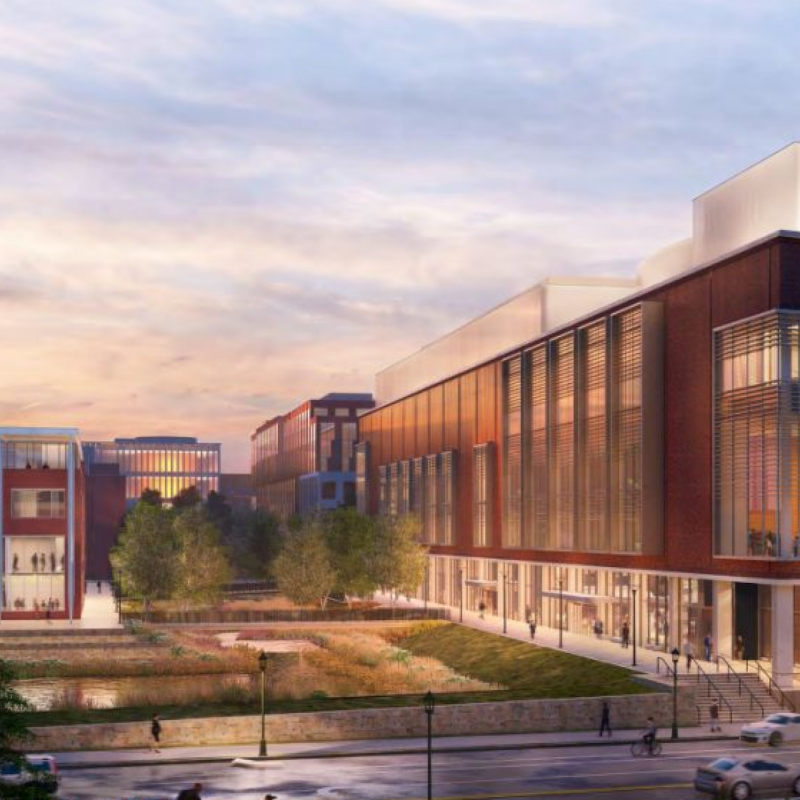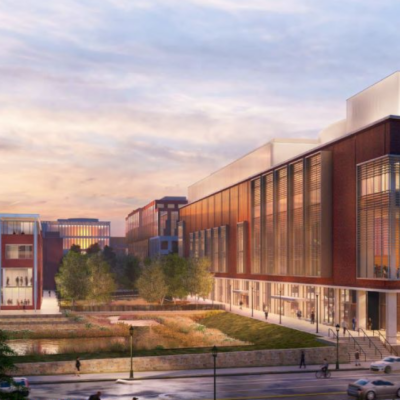
Virginia is for lovers—data center lovers. Nearly half of the nation’s facilities are in the Commonwealth, mostly concentrated in Northern Virginia where there are more data centers than anywhere else in the world. These facilities, which can range from the size of a grocery store to an entire shopping district or larger, use massive amounts of energy, require water to cool off, and often strip communities of their rural character.
Now, Albemarle County officials are deciding how to regulate data center development in our area.
In April 2025, the county settled on an interim zoning ordinance that limits data center development to parts of the county already selected for growth, and established performance standards related to noise, water use, design, and more. According to the ordinance, anything over 40,000 square feet (about the size of the Harris Teeter in Crozet) would require developers to obtain a special use permit—a process that allows community members to weigh in and elected officials to vote on the proposed development.
But on August 6, the Board of Supervisors held a working session in which county planners outlined possible amendments to the ordinance. The amendments strengthened the performance standards in some cases—such as requiring three rows of trees outside facilities instead of two—but also included the option of “overlay districts,” where centers much larger than 40,000 square feet can be built “by right,” and no special permit is needed. As an example, the planning team outlined a tiered system in which centers of up to 125,000 square feet (tier 1) and 500,000 square feet (tier 2) could be built by right.
“All of the areas in the proposed overlay districts are already designated for some type of intense development,” says Bill Fritz, development process manager for Albemarle County. “Data centers would have more requirements than any other uses currently permitted on those properties.”
However, local environmental groups such as the Piedmont Environmental Council feel that the size caps proposed for the overlay districts are much too high, even with performance standards in place. For reference, 500,000 square feet is about the size of the entire 5th Street Station shopping area in Charlottesville. PEC has been at the forefront of data center development in Virginia, and cautions against the energy and water use, noise and air pollution, and deforestation that facilities of that size can pose.
“What’s prudent is to take a conservative approach, requiring the special permits for anything over 40,000 for all of them … and see how it works out,” says Rob McGinnis, senior land use field representative for PEC.
While data centers require significant land, energy, and water use, the tax revenue they provide can be a boon to local governments. Artificial intelligence is increasing the demand for data centers, and as development spreads across the state, Albemarle County leaders have the advantage of looking at other localities as they weigh the pros and cons.
The devil’s in the details
Like the mills and factories that powered the industrial revolution, data centers are the physical footprint of our digital world. These facilities house the servers needed to store, process, and distribute large amounts of data—from video-streaming to emails to companies training AI models.
According to PEC, the energy consumption of these facilities, running 24-7 with on-site generators, far exceeds that of comparable-sized buildings like grocery stores or department stores. Mostly due to data center development, Dominion Energy estimates that Virginia will have to produce twice as much energy in the next 10 years. To do so, Dominion will supplement its renewable energy with new gas-powered plants, which interferes with Virginia’s clean-energy goals. In Albemarle, Fritz says that there’s “no way” the county will meet its own climate goals if super-sized data centers are built.
This energy demand, coupled with the cost of building new plants and infrastructure, will also likely drive up electricity costs for Virginians. According to a report from the Sierra Club Virginia Chapter, Dominion Energy projects that residential electric bills will rise from an average of $142.77 today to $315.25 by 2039—primarily due to the growing energy needs of data centers.
“It’s putting an inappropriate amount of the burden on the rate payers,” says Julie Bolthouse, PEC’s director of land use.
Data centers also run hot, requiring water to cool off. According to the Sierra Club, a single large data center can consume 5 million gallons of water per day, enough to supply 50,000 people. But in Albemarle’s ordinance, data centers are not allowed to use ground water, quelling concerns over diminishing water table levels. The planning team’s proposed amendments also include performance standards that would require centers to use closed-loop cooling systems that recycle water or air cooling systems.
“What we’ve discovered is that through the right types of regulation and the right kinds of design data centers consume [water] at or lower than a comparably sized office building,” says Fritz.
Still, PEC questions the impact of this technology. “Closed-loop cooling doesn’t mean no water use. They still need recycled water, and in other counties, those supplies have simply run out,” says McGinnis.
Landscape change is another aspect to consider. Virginia’s abundance of natural land is one of the reasons why the state has seen such an intense wave of data center development, but the problem is that data centers tend to be built in clusters, with multiple facilities in a single campus. Regionally, this rapid development poses a threat to the state’s rivers, the Chesapeake Bay, and local and migratory wildlife, all of which benefit from the preservation of natural land.
Here in Albemarle, the planning team has proposed that data centers only occur in areas already zoned for development, which is about 5 percent of the county. The rest of the county is zoned for rural use, and the ordinance requires that centers have to be at least 500 feet from the closest rural zone. During the August 6 meeting, Fritz reminded the Board of Supervisors that Albemarle has more land protected under conservation easements than any other locality in Virginia, a measure that helps the county hold on to its rural character.
As for the overlay districts, where larger facilities could be built, the planning team proposed four areas—Emerson/Rivanna Futures, Airport Industrial Area/North Fork Industrial Park, Pantops, and I-64/Route 29—based on criteria related to available infrastructure, land use designation, and locations that limit impacts.
“We [sic] looked closely at access to power. We don’t want to route high-voltage lines through neighborhoods or major commercial corridors,” says Fritz.
Despite these concerns, data centers offer enticing revenue generation through real estate tax and personal property tax on all the equipment inside a facility. Even before developing a data center ordinance, Albemarle County officials were looking for ways to diversify the county’s tax revenue beyond just residential taxes. Data centers would help them meet that goal.
At the August 6 meeting, Jacob Sumner, chief financial officer for Albemarle County, estimated that a data center of 40,000 square feet, 125,000 square feet, and 500,000 square feet would generate roughly $1.3 million, $4 million, and $16 million dollars in tax revenue, respectively. Ned Galloway, who represents the Rio District, discussed what a 500,000-square-foot data center with $16 million in tax revenue could do for the county.
“If we did one that was half of that … and yielded us $8 million in tax revenue, we wouldn’t have had to significantly raise the tax rate to pay for some things that we paid for this past budget cycle,” says Galloway.

Slow down or speed up?
Across Virginia, you’ll find a mix of special use permits and by-right development for data centers, with localities often switching to more special permits following a boom in development.
After initially setting up Technology Overlay Districts with by-right development, Louisa County lowered the size caps and required a conditional use permit (similar to a special use permit) for new data centers in the district. This was largely in response to community concerns following the approval of two large data centers totaling 980 acres for Amazon Web Services. In a similar fashion, Loudoun County and Culpeper County now also require permits in places where by-right development was initially allowed.
Fritz sees these stories as warning signs that other counties should heed. “Something’s happened here,” he says. “They learned something.”
According to Christina Libre, an associate attorney with the Southern Environmental Law Center, special use permits are a way to establish transparency and allow local officials to address environmental impacts on a case-by-case basis. “It gives the county the opportunity to monitor those aggregate impacts and then adjust [its] approach to future development as needed,” says Libre. SELC, like PEC, recommends that Albemarle County require a special use permit for any center over 40,000 square feet.
However, some argue that if solid performance regulations are in place to limit community impact, then there’s no need for a special use permit process, which costs the county money and can deter investment. With a tiered system, the idea is that the county could put stronger performance requirements on the largest-sized facilities to limit impact.
“If you go through the process of developing the appropriate list of supplemental regulations, those would be the regulations you would normally put on a special use permit,” says Fritz.
During the working session, some Board of Supervisors members showed support for the overlay district concept, while others were firmly against by-right development for anything over 40,000 square feet. Ann Mallek, who represents the White Hall District, commended the planning team’s research while admitting that this is a new issue for the county.
“Because we are beginners in this, we are facing a lot of risk due to our inexperience,” says Mallek.

Existing ordinance to stay in effect
On October 1, the Albemarle County Community Development Department recommended that the Board of Supervisors pause the consideration of new data center regulation, citing the rapidly changing nature of the data center regulatory environment.
According to county officials, a pause in adoption of new ordinances will allow the county to evaluate and implement any potential legislation adopted by the Virginia General Assembly in the January, 2026 legislative session. The previously scheduled Planning Commission Public Hearing and Board of Supervisors Public Hearing have been cancelled.
For now, the county will continue to rely on its existing ordinance, which allows by right development for data centers of under 40,000 square feet in industrial zones. So far, no data centers have been proposed, though the door is open.
“If a datacenter proposal came in tomorrow, we would process it,” says Fritz.
An earlier version of this story incorrectly attributed a quote to Bill Fritz. The attribution has been changed to Rob McGinnis.





